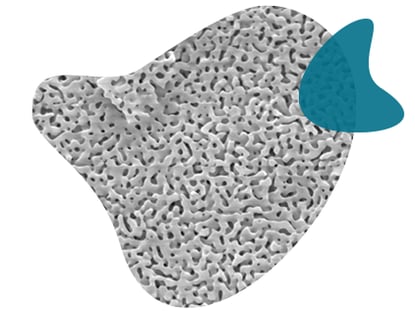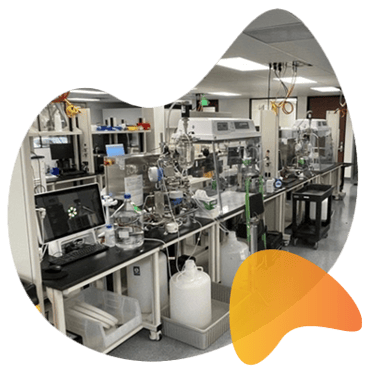Originally published : Wed, March 20, 2024 @ 5:15 PM
With more companies than ever innovating in precision medicine, drug discovery, therapeutic development and genetic testing, the demand for high-quality, customised oligonucleotides is growing and will continue to do so. This means greater need for controlled pore glass (CPG), a critical component in the solid-phase chemical synthesis of oligonucleotides.
Manufacturing CPG can generate large volumes of wastewater that must be treated. Increased demand for CPG makes sustainable production even more important. As market leaders in this critical supply chain, LGC Biosearch Technologies is at the forefront of reducing the waste products of CPG manufacturing, helping to meet growing demand without compromising our environmental responsibilities.
What is controlled pore glass?
CPG is a specialised high-silica glass with pores in which oligo synthesis occurs. CPG is rigid and features deep pores characterised by a distinct size distribution. These porous glasses can be crafted into various geometric shapes – such as frits, rods, plates, beads and hollow spheres – with the ability to finely adjust pore dimensions from angstroms to millimetres. The precise regulation of pore sizes enables manufacturers to customise the glass's physical and chemical reactivity towards gases and liquids.
 A typical CPG particle is 100 μm (or 0.01 cm), similar to the width of a strand of human hair. Each CPG particle, in turn, contains thousands of pores, each with uncountable branches, which are even smaller, typically ~0.05 μm in size (or 0.000005 cm).
A typical CPG particle is 100 μm (or 0.01 cm), similar to the width of a strand of human hair. Each CPG particle, in turn, contains thousands of pores, each with uncountable branches, which are even smaller, typically ~0.05 μm in size (or 0.000005 cm).
Different pore sizes are used depending on the length of the oligonucleotide to be synthesised. For instance, the long single guide RNAs (sgRNA) for CRISPR applications require 2000 Å or 3000 Å CPG. CPGs are also produced with a range of functional modifications to tailor the 3ʹ end of the oligo, adding a fluorophore or increasing the stability, for example.
Porous glass can be manufactured via different routes, each of which creates characteristic pore structures. At Biosearch Technologies, we typically use alkali borosilicate system approach to manufacture our controlled pore glass from special custom raw glass.
Overview of the alkali borosilicate approach:
- Annealing: Sodium borosilicate glass is heated to a very high temperature for a period of time. During this stage, the boron oxide and sodium oxide separate from the silicon oxide, forming the basis of the pore structure.
- Milling: The glass frit is milled into the desired particle size and sieved.
- Acid leaching: Hot acid is used to remove the boron and sodium oxide.
- Base leaching: An alkali base is used to remove the silicon first in the pores and then to widen the pores to the desired surface state by removing silicon on the pore surface.
Pioneering a sustainable future in CPG production
The production of CPG is resource-intensive, both in terms of the raw materials used and the waste that must be processed.
 Approximately 141 kg of raw glass is required to make 12 kg of CPG – a 8.5% yield (in mass), or a 35% yield (in volume). Each 12 kg lot of CPG produces 8-12 m3 of liquid waste, which needs to be purified at an external specialist waste management company.
Approximately 141 kg of raw glass is required to make 12 kg of CPG – a 8.5% yield (in mass), or a 35% yield (in volume). Each 12 kg lot of CPG produces 8-12 m3 of liquid waste, which needs to be purified at an external specialist waste management company.
Our site in Steinach, Germany can produce several tonnes of controlled pore glass each year, the majority of which travels to our site in Petaluma for further functionalisation and oligonucleotide synthesis.
Sustainability is at the core of our future-focused operations. Over the last two years, our team at Steinach have conducted more than 150 experiments to help streamline the CPG production process, making our manufacturing more efficient, reducing environmental impact and making it better suited for scalping up.
Our scientists experimented by varying a wide range of parameters, e.g., acid temperature, type of acid, concentration of base and temperature of base. As a result, our teams have developed a new manufacturing style called NextGen, which consists of two acid and three base treatments.
This new CPG manufacturing process delivers important benefits while maintaining existing quality requirements, including density, pore diameter, pore volume and surface.
Benefits of our new NextGen method include:
- Twice as fast as existing processes (48 hours per batch vs 96 hours)
- Reduced costs
- More streamlined, because the in situ washing between leaching steps eliminates the need to transfer solids between reactor and filters for washing
- Up to a 50% reduction in wastewater volume
- Significantly reduced energy use since no heating is required.
Towards a greener horizon
The NextGen CPG manufacturing process is a step towards a more sustainable future in biotechnology. Preliminary results from our quality assurance and oligonucleotide synthesis tests show promising improvements in performance. Biosearch Technologies has set new standards for the industry in quality, innovation and sustainability. Our expertise, backed by rigorous research and a commitment to environmental stewardship, will continue to support the scientific community with products that drive the future of biotechnology.
If you’d like more information on greener CPGs by Biosearch Technologies or require support with your in-house set-up, please contact us.
Related content


